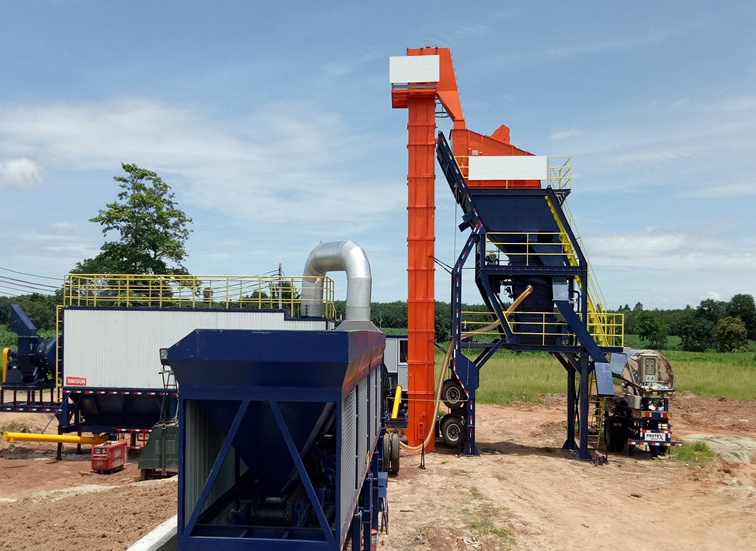Mobile Asphalt Mixing Plant for Road Construction
Mobile asphalt mixing plant is a kind of equipment that mixes stone, asphalt and mineral powder according to a certain proportion to produce asphalt mixture. Compared with the fixed asphalt station, the unique walking system makes the transition more convenient.
Asphalt mixing plant refers to a comprehensive set of equipment designed for the mass production of asphalt. It is capable of producing various types of asphalt mixtures, including standard, modified, and colored asphalt. This equipment is essential for constructing expressways, grade roads, municipal roads, airports, and ports.
Mobile Asphalt Drum Mix Plant
The mobile asphalt drum mix plant consists of several key components: a cold material supply system, an asphalt supply system, a drying and mixing drum, a dust removal system, a walking system, and a control system. It is primarily used for small to medium-sized road construction projects or low-grade roads. Notable for its compact design, ease of mobility, and cost-effectiveness, this plant is well-suited for such applications.
The main workflow is as follows:
1. Loading: Cold aggregates of various specifications are loaded into the cold aggregate hopper using a loader. These aggregates are then conveyed via a belt conveyor to a vibrating screen, where any material smaller than 40mm is separated and discarded.
2. Drying and Mixing: The qualified cold aggregates are transported to the drying and mixing drum via a belt conveyor. Simultaneously, asphalt is delivered to the drum through a pipeline. Inside the drum, the cold aggregates and bitumen are mixed and dried to produce a homogeneous asphalt mixture. Dust generated from the aggregates is captured by the dust collector, preventing environmental contamination.
3. Storage: The finished asphalt is transferred to the asphalt storage bucket by a bucket elevator for temporary storage and insulation. It is then ready to be transported to the construction site by dump truck.
Mobile Asphalt Forced Mix Plant
Mobile Asphalt Forced Mix Plant
The mobile asphalt forced mix plant operates similarly to a fixed asphalt plant but includes a walking system for enhanced mobility. It features a forced mixer that ensures thorough mixing of cold aggregates and asphalt, resulting in a higher-quality finished product. This type of plant is typically used for constructing expressways and airport roads where strict quality standards are required. It is characterized by high automation, precise product specifications, and ease of transportation.
The main workflow is as follows:
1. Loading: Cold aggregates of various specifications are loaded into the collecting hopper using a loader. After primary weighing, these materials are conveyed by a belt conveyor to the drying drum for heating and drying.
2. Dust and Moisture Removal: During the drying process, dust and moisture from the aggregates are collected by a bag dust collector.
3. Screening and Storage: The hot aggregates, heated in the drying drum, are lifted by a hoist to the vibrating screening system above the mixing building. The aggregates are screened into different sizes and then directed to separate storage hoppers. They are later weighed according to specific ratios using a weighing device.
4. Mineral Powder and Bitumen Weighing: Mineral powder is transferred to a temporary storage hopper via a powder elevator and weighed. Simultaneously, bitumen is delivered to the bitumen metering device through a pipeline for precise measurement.
5. Mixing: The weighed aggregates, mineral powder, and bitumen are sequentially added to a twin-shaft mixer. After mixing for the specified time, the discharge door of the mixer is opened, and the homogeneous mixture is deposited into the finished product warehouse.
6. Transportation: The finished mixture is loaded into a dump truck and transported to the construction site.
How to Choose a Site for a Mobile Asphalt Plant
With the rapid expansion of infrastructure projects, the demand for asphalt mixing plants has increased significantly. Proper site selection for a mobile asphalt plant is crucial as it affects both the efficiency of operations and the quality of the asphalt mixture. Here are key factors to consider when choosing a site:
Distance from Construction Site
The distance between the mobile asphalt plant and the construction site is crucial for optimizing both profit and the quality of the asphalt. To ensure efficient paving temperatures and cost-effective transportation, it is generally recommended that the transportation distance be within 80 kilometers, with a maximum limit of 100 kilometers. This helps balance the cost and effectiveness of asphalt delivery.
Ease of Raw Material Supply
Mobile asphalt plants require substantial quantities of raw materials, including sand, slag, and asphalt, as well as fuel such as oil or natural gas for the combustion system. It is essential to consider the availability and timely supply of these materials, as well as the transportation costs associated with them, when selecting a site.
Geological Conditions
The site’s geological stability is a critical factor. Assess whether the location is prone to geological hazards such as fractures or landslides, if there is significant stagnant water, or if the land is sandy. These conditions can impact the foundation work for the asphalt mixing plant and, consequently, affect construction costs.
Surrounding Environment
Asphalt mixing plants are highly mechanized and can generate dust and noise during operation. To minimize environmental impact, avoid sites near schools, residential areas, and other sensitive locations. Choosing a site with minimal potential for affecting nearby communities helps in adhering to environmental regulations and reducing complaints.















